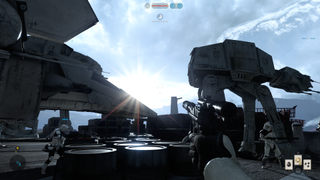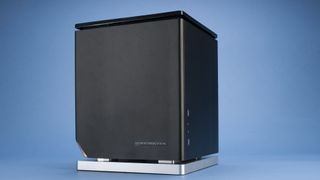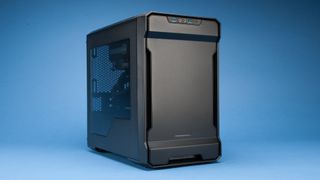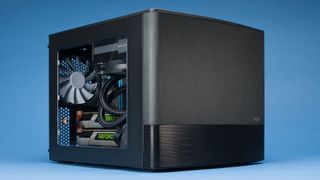Star Wars: Battlefront Optimization Guide

The Builds
We put our Blueprints builds from fall 2015 through the ringer to figure out what settings we could get away with on each machine. We know that not everyone's rig will match what we have built, but the builds can serve as a guide to get an idea of what you can do with similar hardware.
We played Battlefront on each machine, and used Fraps to calculate our average frame rate.While there will always be some variation based on number of players and effects that are in frame at any given moment, we did our best to get right in the thick of any firefights that were going on (for better or worse). Here's what we found.
The Budget Gamer

The Fall 2015 Budget Gamer has fairly modest specs. With a 4GB GeForce GTX 960 and an Intel Core i5-6500 Skylake, this rig is the least powerful of the three. Don't let the name fool you, though: This rig is budgeted to be around $800 (when we built it, the tab came to $770), and it's quite the capable 1080p gaming rig.
Since the GTX 960 isn't really built for gaming over 1080p, we started from there and worked our way through the preset settings. We first tried playing with the Ultra preset, but we found ourselves dipping into the high 40s and low 50s at times while in combat. To perk up our frame rates, we nudged the graphics settings down to High and began to customize them from there. We were eventually able to eke out an average of 65fps, and got away with upping a setting or two as well.
| Setting | Value |
| Fullscreen Resolution | 1920x1080 |
| Resolution Scale | 100% |
| Texture Quality | High |
| Texture Filtering | High |
| Lighting Quality | Ultra |
| Shadow Quality | High |
| Effects Quality | High |
| Post Process Quality | High |
| Mesh Quality | High |
| Terrain Quality | Ultra |
| Terrain Groundcover | High |
| Anti-aliasing | Medium |
| Ambient Occlusion | High |
As we played with some of the settings, we found that we couldn't find much play in a lot of the heavy-hitting settings. However, we did spend some power on the terrain. We did this for one big reason: The maps in Battlefront are quite expansive and open in many places. By keeping the landscape geometry at a high quality, we environment stays looking good. This is especially noticeable when flying X-wings or TIE fighters. Draw distance of terrain and ground features when flying low can make a big difference between flying nap-of-the-earth or into-the-earth.
We decided to set the lighting settings to Ultra because it turned out to be only a modest hit to frame rates. We tried adding shadows to the mix, but couldn't keep frame rates above 60 when we did so. As it turns out, Battlefront has a lot of dynamic shadows and dark areas (just look at the images of Endor).
While some could argue in favor of boosting other settings, the GTX 960 does great at the High preset, once you nudge anti-aliasing down to Medium. Anti-aliasing is not cheap, and aside from the raw render size, is probably going to be the biggest hit on a game when cranked up. Everything else after that is a personal choice on where you want to spend your extra frames, since you really can't have everything.
Comic deals, prizes and latest news
Sign up to get the best content of the week, and great gaming deals, as picked by the editors.
The Midrange

The Midrange build is only mediocre in name. We usually build the Midrange to be a powerful single-GPU rig paired with a K-SKU Core i7 or equivalent, with a budget target of about $1,500. For Fall 2015, we packed a Core i7-6700K and a reference model GeForce GTX 980 into a Phanteks Enthoo Evolv mini-ITX case. This rig offers plenty of power in a small form factor, which is great for folks who are a little short on spare desk space.
The GTX 980 is a powerful workhorse that can handle just about anything, but falls just short of the 4K gaming mark. As such, we didn't have to do much to the settings to get a great experience. At 2560x1440, this rig performed admirably, pulling off 72fps on average. That's using the Ultra graphics quality preset, mind you.
| Setting | Value |
| Fullscreen Resolution | 2560x1440 |
| Graphics Quality (preset) | Ultra |
While we were able to get the Ultra settings going at full clip at 1440p, there is still one more thing we could recommend to get the best image quality possible: resolution scale. To get a little extra prettiness out of each frame, we'd recommend toying with supersampling a bit until you get down to an average frame rate of about 65 or so.
For those of you who have G-Sync monitors capable of 90 or 144Hz, turning down anti-aliasing a notch could yield you an average frame rate even higher than 72fps, and will likely reach into the mid 80s. This same advice can go for R9 Fury owners who have a FeeSync monitor to pair with their system.
The Turbo

The Turbo rig we build isn't the type of computer you build on a budget. It's not the type of thing you give to your college-bound kid, either. It's pure, unadulterated, enthusiast-grade power with a price target of $3,000. It's the Dream Machine's younger cousin. And when it comes to Battlefront, it plays like a dream.
The Turbo build took advantage of two reference GeForce GTX 980 Ti video cards in SLI paired with a Core i7-5820K Haswell-E CPU. We mounted these components on an Asus micro-ATX board and stuck them into Fractal Design's Node 804 case. This rig didn't even blink when we ran Battlefront at 4K, giving us 70fps at the Ultra preset.
| Setting | Value |
| Fullscreen Resolution | 3840x2160 |
| Resolution Scale | 115% |
| Graphics Quality (preset) | Ultra |
There really wasn't much to say when it came to tuning this rig, except that we had plenty of frame rate headroom to up the supersampling. Even at 115 percent scaling, we pulled off frame rates that topped 70fps. We could probably scale up to 118 or 120 percent while staying over 60fps, if we wanted.
People who are going to build this type of rig should definitely pair it with a monitor to match. The Dell UP2414Q 4K monitor we used with this rig isn't really a gaming monitor, though it can hit 60Hz at 4K when using DisplayPort 1.2. For gamers who prefer higher refresh rates and at 1440p, this rig will definitely put a high-end monitor's 144Hz refresh rate to use.
With the UP2414Q's pixel density, you can make the argument to turn down anti-aliasing at 4K. The process is really expensive at 4K, and at that resolution (and density), jaggies are pretty tough to make out. Turning anti-aliasing to medium or low would suffice for most, allowing for yet higher frame rates.
For all its flaws, Star Wars: Battlefront is a beautiful game to look at and listen to. The game is quite playable at 1080p with modest hardware as well. Knowing what your hardware can do will help keep expectations in line, and ultimately reward you with a fun experience full of eye candy.
Let us know what hardware and settings you're playing with, and may the (Ge)Force be with you.
Most Popular



